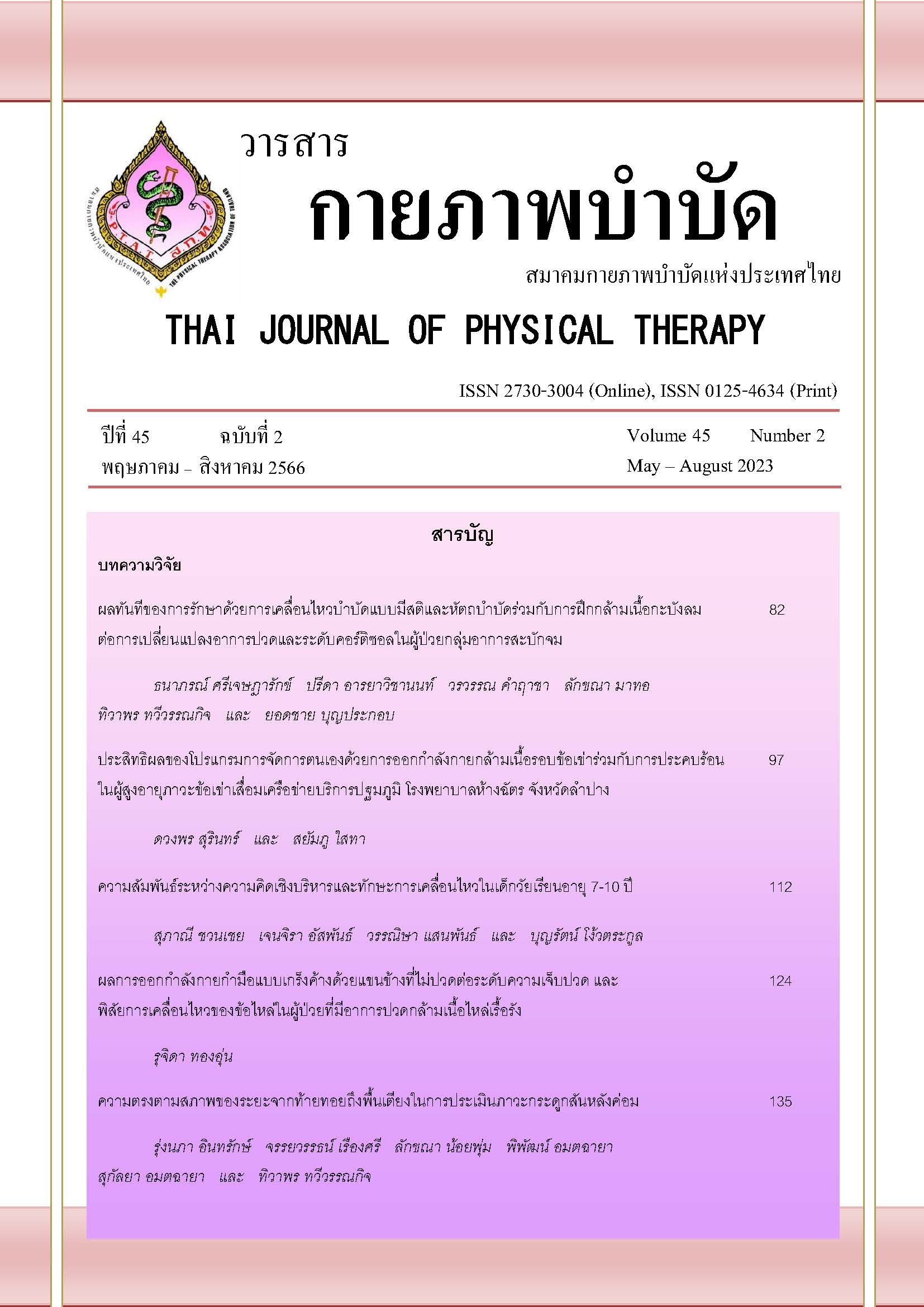ผลการออกกำลังกายกำมือแบบเกร็งค้างด้วยแขนข้างที่ไม่ปวดต่อระดับความเจ็บปวด และพิสัยการเคลื่อนไหวของข้อไหล่ในผู้ป่วยที่มีอาการปวดกล้ามเนื้อไหล่เรื้อรัง
Main Article Content
บทคัดย่อ
ที่มาและความสำคัญ: การออกกำลังกายกล้ามเนื้อกำมือแบบเกร็งค้างด้วยแขนข้างที่ไม่ปวดถูกพบว่าช่วยเพิ่มค่าระดับขีดกั้นความเจ็บปวดในผู้ป่วยที่มีอาการปวดกล้ามเนื้อไหล่เรื้อรัง อย่างไรก็ตาม ยังไม่มีการศึกษาผลของการออกกำลังกายนี้ต่อพิสัยการเคลื่อนไหว
วัตถุประสงค์: เพื่อศึกษาผลทันทีของการออกกำลังกายกำมือแบบเกร็งค้างต่อระดับความเจ็บปวด และพิสัยการเคลื่อนไหวในผู้ป่วยที่มีอาการปวดกล้ามเนื้อไหล่เรื้อรัง
วิธีการวิจัย: การศึกษานี้เป็นการวิจัยกึ่งทดลอง แบบกลุ่มเดียว ก่อนและหลังการทดลอง (one group pretest-posttest design) ผู้ป่วยที่มีอาการปวดกล้ามเนื้อไหล่เรื้อรังข้างเดียว จำนวน 40 ราย (อายุเฉลี่ย 57.75 ปี, พิสัย 30-75) ทำการออกกำลังกายกำมือแบบเกร็งค้างที่ 25% ของแรงกำมือสูงสุด (MVIC) นาน 3 นาที ด้วยแขนข้างที่ไม่ปวด ก่อนและหลังออกกำลังกายทันทีได้มีการวัดระดับความเจ็บปวด และวัดพิสัยการเคลื่อนไหวข้อไหล่ขึ้นเหนือศีรษะข้างที่ปวด
ผลการวิจัย: พบว่ามีการเพิ่มขึ้นของพิสัยการเคลื่อนไหวของข้อไหล่ทั้งที่เริ่มกระตุ้นอาการปวด และพิสัยที่ปวดมากที่สุดที่ไม่สามารถไปต่อได้ภายหลังการออกกำลังกายกำมือแบบเกร็งค้างด้วยแขนข้างที่ไม่ปวด ค่าเฉลี่ยของพิสัยการเคลื่อนไหวของข้อไหล่ที่เริ่มกระตุ้นอาการปวดก่อนและหลังการออกกำลังกายคือ 115.13 ± 25.67 และ 125.63 ± 30.59 องศา ตามลำดับ ค่าเฉลี่ยของพิสัยการเคลื่อนไหวของข้อไหล่ที่ปวดมากจนไม่สามารถเคลื่อนไหวข้อไหล่ต่อได้ก่อนและหลังการออกกำลังกายคือ 154.68 ± 23.96 และ 160.03 ± 19.04 องศา ตามลำดับ ซึ่งมีความแตกต่างอย่างมีนัยสำคัญทางสถิติของค่าพิสัยการเคลื่อนไหวของข้อไหล่ที่เริ่มประตุ้นอาการปวด (p = 0.001) และพิสัยที่ปวดมากจนไม่สามารถเคลื่อนไหวข้อไหล่ต่อได้ (p = 0.015) ก่อนและหลังการออกกำลังกาย โดยไม่พบการเปลี่ยนแปลงอย่างมีนัยสำคัญของค่าระดับความเจ็บปวดที่พิสัยทั้งสอง (p = 0.853 และ p = 0.393)
สรุปผล: การออกกำลังกายกำมือแบบเกร็งค้างที่ 25% MVIC นาน 3 นาที ด้วยแขนข้างที่ไม่ปวด ในผู้ป่วยที่มีอาการปวดกล้ามเนื้อไหล่เรื้อรัง สามารถเพิ่มพิสัยการเคลื่อนไหวไหล่ข้างที่ปวดได้ทันที
Article Details

อนุญาตภายใต้เงื่อนไข Creative Commons Attribution-NonCommercial-NoDerivatives 4.0 International License.
เอกสารอ้างอิง
Lucas J, van Doorn P, Hegedus E, Lewis J, van der Windt D. A systematic review of the global prevalence and incidence of shoulder pain. BMC Musculoskelet Disord 2022; 23(1): 1073.
Le HV, Lee SJ, Nazarian A, Rodriguez EK. Adhesive capsulitis of the shoulder: review of pathophysiology and current clinical treatments. Shoulder Elbow 2017; 9(2): 75-84.
Wall BT, Dirks ML, Snijders T, Senden JM, Dolmans J, van Loon LJ. Substantial skeletal muscle loss occurs during only 5 days of disuse. Acta Physiol (Oxf) 2014; 210(3): 600-11.
Dueñas L, Aguilar-Rodríguez M, Voogt L, Lluch E, Struyf F, Mertens MGCAM,et al. Specific versus non-specific exercises for chronic neck or shoulder pain: a systematic review. J Clin Med 2021;10(24):5946. doi: 10.3390/jcm10245946.
Gordon R, Bloxham S. A systematic review of the effects of exercise and physical activity on non-specific chronic low back pain. Healthcare (Basel) 2016; 4(2): 22.
Hanratty CE, Kerr DP, Wilson IM, et al. Physical therapists' perceptions and use of exercise in the management of subacromial shoulder impingement syndrome: focus group study. Phys Ther 2016; 96(9): 1354-63.
Naugle KM, Naugle KE, Fillingim RB, Riley JL. Isometric exercise as a test of pain modulation: effects of experimental pain test, psychological variables, and sex. Pain Med 2013; 15(4): 692-701.
Umeda M, Newcomb LW, Ellingson LD, Koltyn KF. Examination of the dose-response relationship between pain perception and blood pressure elevations induced by isometric exercise in men and women. Biol Psychol 2010; 85(1): 90-6.
Park G, Kim CW, Park SB, Kim MJ, Jang SH. Reliability and usefulness of the pressure pain threshold measurement in patients with myofascial pain. Ann Rehabil Med 2011; 35(3): 412-7.
Gajsar H, Titze C, Hasenbring MI, Vaegter HB. Isometric back exercise has different effect on pressure pain thresholds in healthy men and women. Pain Med 2017; 18(5): 917-23.
Vaegter HB, Lyng KD, Yttereng FW, Christensen MH, Sorensen MB, Graven-Nielsen T. Exercise-induced hypoalgesia after isometric wall squat exercise: a test-retest reliability study. Pain Med 2019; 20(1): 129-37.
Koltyn KF, Umeda M. Contralateral attenuation of pain after short-duration submaximal isometric exercise. J Pain 2007; 8(11): 887-92.
Jones MD, Taylor JL, Booth J, Barry BK. Exploring the mechanisms of exercise-induced hypoalgesia using somatosensory and laser evoked potentials. Front Physiol 2016; 7: 581.
Lannersten L, Kosek E. Dysfunction of endogenous pain inhibition during exercise with painful muscles in patients with shoulder myalgia and fibromyalgia. Pain 2010; 151(1): 77-86.
Staud R, Robinson ME, Price DD. Isometric exercise has opposite effects on central pain mechanisms in fibromyalgia patients compared to normal controls. Pain 2005; 118(1-2): 176-84.
Burrows NJ, Booth J, Sturnieks DL, Barry BK. Acute resistance exercise and pressure pain sensitivity in knee osteoarthritis: a randomised crossover trial. Osteoarthritis Cartilage 2014; 22(3): 407-14.
Treede RD, Rief W, Barke A, Aziz Q, Bennett MI, Benoliel R, et al. Chronic pain as a symptom or a disease: the IASP Classification of Chronic Pain for the International Classification of Diseases (ICD-11). Pain 2019; 160(1): 19-27.
Itthipongsathorn N, Phonghanyudh T, Nitikornatiwat P. Prevalence of fibromyalgia at the physical medicine and rehabilitation outpatient clinic in Phramongkutklao Hospital. J Thai Rehabil Med 2016; 26(1): 24-30.(in Thai)
Naugle KM, Naugle KE, Riley 3rd JL,. Reduced modulation of pain in older adults after isometric and aerobic exercise. J Pain 2016; 17(6): 719-28.
Hawker GA, Mian S, Kendzerska T, French M. Measures of adult pain: Visual Analog Scale for Pain (VAS Pain), Numeric Rating Scale for Pain (NRS Pain), McGill Pain Questionnaire (MPQ), Short-Form McGill Pain Questionnaire (SF-MPQ), Chronic Pain Grade Scale (CPGS), Short Form-36 Bodily Pain Scale (SF-36 BPS), and Measure of Intermittent and Constant Osteoarthritis Pain (ICOAP). Arthritis Care Res (Hoboken) 2011; 63 Suppl 11: S240-52.
Xu ZY, Gao DF, Xu K, Zhou ZQ, Guo YK. The effect of posture on maximum grip strength measurements. J Clin Densitom 2021; 24(4): 638-44.
Reese NB, Bandy WD. Joint range of motion and muscle length testing. Philadelphia: W.B. Saunders Company; 2002.
Portney LG, Watkins MP. Foundations of clinical research. Applications to practice. 2nd ed. Upper Saddle River: Prentice Hall Health; 2000.
Rice D, Nijs J, Kosek E, Wideman T, Hasenbring MI, Koltyn K, et al. Exercise-Induced Hypoalgesia in Pain-Free and Chronic Pain Populations: State of the Art and Future Directions. J Pain 2019; 20(11): 1249-66.
Vaegter HB, Jones MD. Exercise-induced hypoalgesia after acute and regular exercise: experimental and clinical manifestations and possible mechanisms in individuals with and without pain. Pain Rep 2020; 5(5): e823.
Bidari A, Ghavidel-Parsa B, Rajabi S, Sanaei O, Toutounchi M. The acute effect of maximal exercise on plasma beta-endorphin levels in fibromyalgia patients. Korean J Pain 2016; 29(4): 249-54.
Koltyn KF, Brellenthin AG, Cook DB, Sehgal N, Hillard C. Mechanisms of exercise-induced hypoalgesia. J Pain 2014; 15(12): 1294-304.
Crombie KM, Brellenthin AG, Hillard CJ, Koltyn KF. Endocannabinoid and opioid system interactions in exercise-induced hypoalgesia. Pain Med 2018; 19(1): 118-23.
Ring C, Edwards L, Kavussanu M. Effects of isometric exercise on pain are mediated by blood pressure. Biol Psychol 2008; 78(1): 123-8.
Colby L, Borstad J. Resistance exercise for impaired muscle performance. In: Kisner C, Colby LA, Borstad J, eds. Therapeutic exercise Foundations and techniques. 7th ed. Philadelphia: F. A. Davis Company; 2007: 166-245.


